 |
Horsemanship Education - Immerse Yourself in Horses
These photos provide a sampling of our horsemanship
activities, including horse training and handling, riding, and care. These
horses and participants have learned our horsemanship methods and so know
what to
do. Please do not try what you see here unless you have been properly
instructed and your horse has been properly trained.
For photos of research activities, visit our horse
research pictures page.
Groundwork For Good Relationships
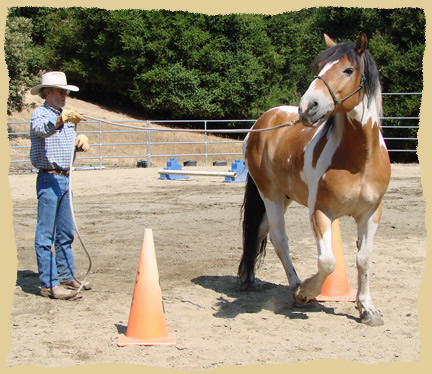
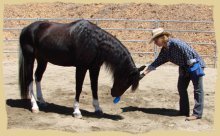
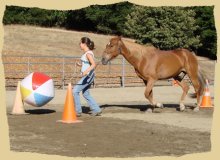
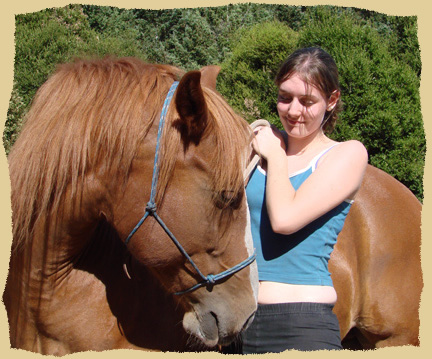
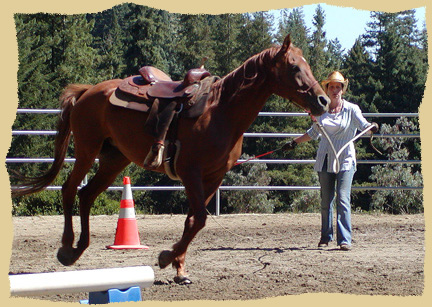
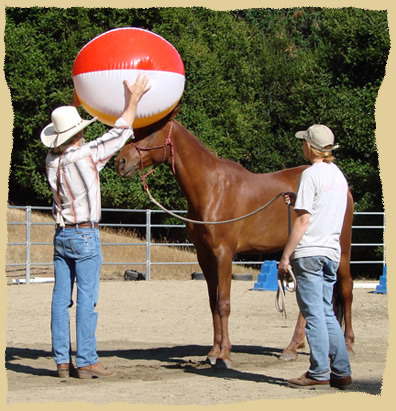 |
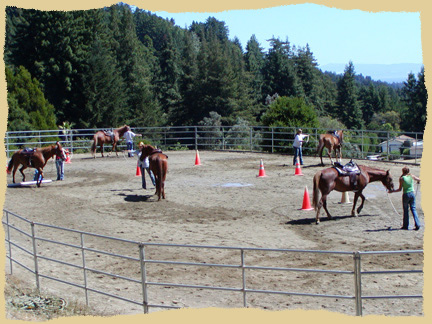
Good horsemanship starts on the ground. Participants
learn how to get their horses to respond to them using body language based on equine behavior.
Horses can be taught to perform all sorts of behaviors and be light on the lead rope. The Pinto is walking figure-eight patterns around the cones while the trainer stands still.
With positive reinforcement and target training, behaviors such as lowering the head are taught easily, with no force or pressure.
Groundwork helps teach respect. Once a good human/horse relationship is established
all sorts of games can be played, which exercises not only the horse's body
but also the mind.
Horse behaviors that are useful in the saddle, such as lateral bending, can be taught from the ground first. This makes transfer to the saddle easier and safer.
Circling the horse a few times in each direction and in each gait allows
the rider who strives for good horsemanship to look for any potential problems,
either physical or mental, before getting in the saddle.
Desensitizing horses to all sorts of unusual sights, sounds, and smells on the ground better prepares them for the trail.
|
Horseback Riding Through Good Horsemanship
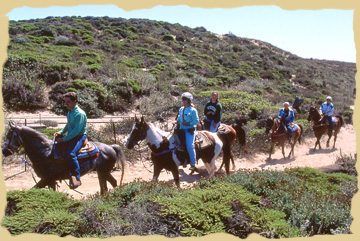
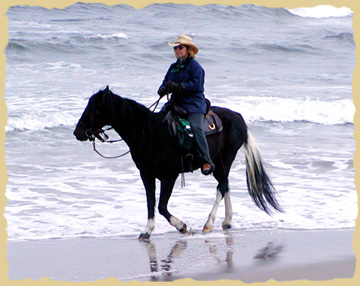
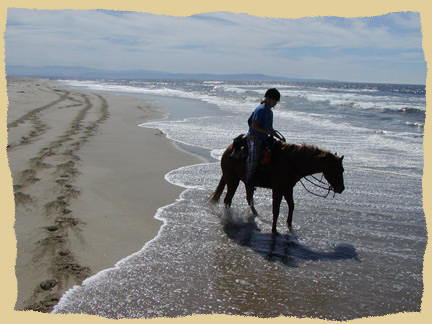
|
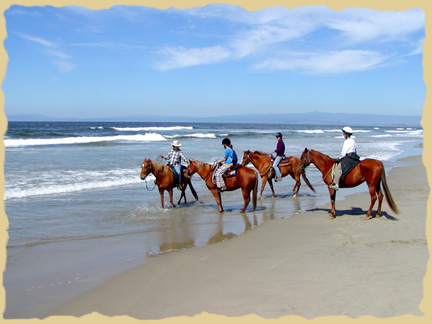
Once
good on the ground, horse riding becomes fun and relaxing.
Trail riding becomes more pleasurable once good relationships are established
and bonds form between horses and their riders.
|
Horse Training Clinics

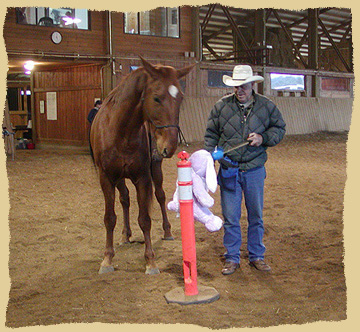
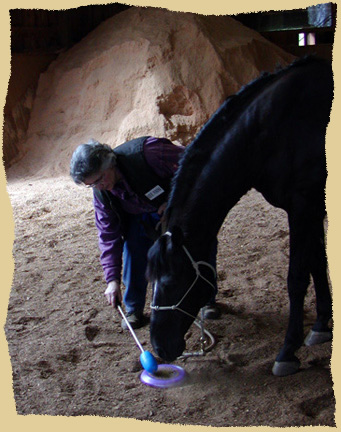
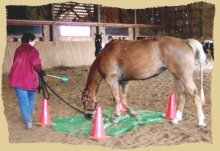
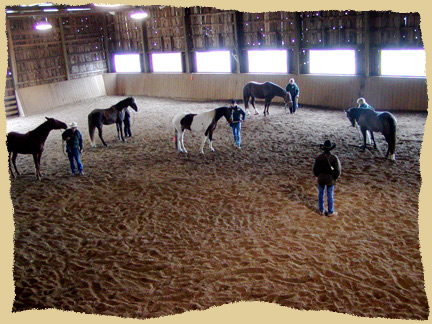
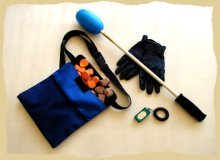 |
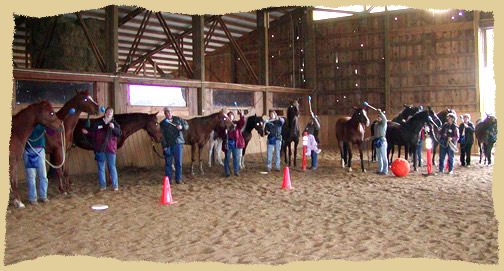
The Equine Research Foundation conducts positive reinforcement
horse training clinics in the western states. For more information, please
see our positive
reinforcement clinics page. With positive reinforcement, all kinds of
behaviors can be taught including behaving politely around food, lifting
feet for cleaning, standing quietly for farrier and vet care, trailer loading
and unloading, the possibilities are endless. Horses become highly motivated
and eagerly
seek
the "right answer." Training becomes enjoyable,
exciting, and stress-free.
Equine Research Foundation clinic participants and their horses learn about
positive reinforcement and good horsemanship in this Oregon facility.
Equine Research Foundation clinician, Jerry Ingersoll, leads a discussion
on horsemanship during a positive reinforcement clinic.
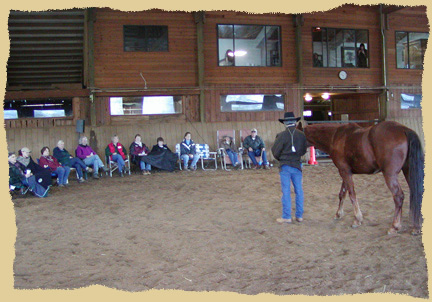
Positive reinforcement horse training clinics help horses better deal with
unusual situations. Horses learn to follow and focus on a target (an object
attached to a handle), which helps them accept strange
objects, such as
fuzzy purple bunnies.
Not only is target training the start to teaching horses to play Frisbee,
it also can be used to train horses to go to a stationary target and remain
there until called off.
Positive reinforcement works wonders in helping horses overcome fear and
resistance and become braver.
Clinician Dr. Evelyn B. Hanggi and her Missouri Foxtrotter demonstrating
following at liberty after positive reinforcement training.
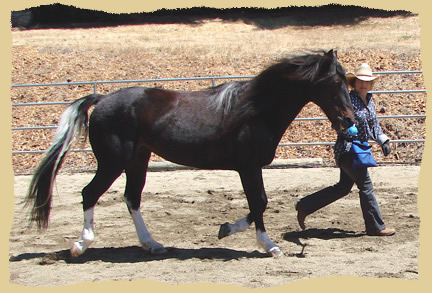
The Equine Research Foundation positive reinforcement training
tools: a closeable belted pouch, a handheld target, a
clicker with wrist coil for initial training, a stationary
target (not shown), thin leather gloves, food that horses like and,
most importantly, knowledge. The
training tool starter kit is available to participants through the Equine Research Foundation.
Please contact
us or check back in the future to see when kits will be available to nonparticipants.
|
Simply Having Fun With Horses
More Positive Reinforcement Training
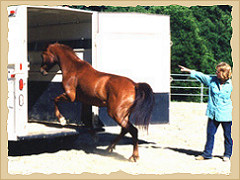
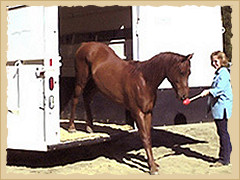
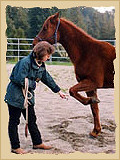 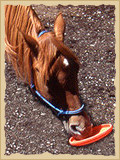
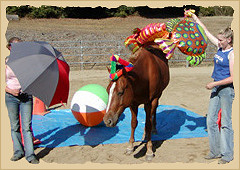 |
Fun and useful behaviors for training, handling, and care can be taught through positive reinforcement.
It's an excellent method for training behaviors such as:
trailer loading on only a hand gesture - no whips, no ropes, no force unloading just as easily using a target lifting feet on a verbal cue -
playing games
-
becoming braver around all sorts of odd things
The possibilities are limited only by imagination. |
Habituation and Desensitization
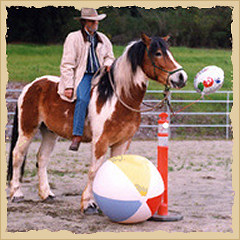 |
Because
horses are prey animals they are naturally wary of the unknown. This instinct,
although a lifesaver for horses in the wild, can be hazardous for humans. Proper
training helps horses relax around the unexpected. The result? A much safer
partnership. |
Eclectic Horsemanship
If you'd like to learn more about equine thinking, perception, and behavior,
building relationships with and training horses or working through human-horse
problems, we invite you to:
Copyright Notice: All literature and photographs on this website are the exclusive property of
the Equine Research Foundation or the scientific journals in which articles
appear. The literature and photographs may not be downloaded or reproduced,
copied, used or altered in any way without the written permission of the Equine
Research
Foundation.

|

